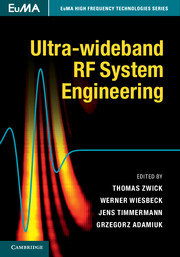5 - Monolithic integrated circuits for UWB transceivers
Published online by Cambridge University Press: 05 December 2013
Summary
The great interest in UWB systems is well-motivated by the huge signal bandwidth. As shown in the previous chapters, the ultra-wide signal bandwidth has many benefits, such as very high data transmission rates and very fine time resolution. Either or both of these potentials would be very attractive for short-range communication systems, if a substantial advantage in terms of power consumption or performance could be achieved compared to existing radio solutions. In particular, the possible time resolution well below 1 ns is a unique feature, which seems to be the enabler for precise indoor localization. Unfortunately, the huge signal bandwidth demands an appropriate circuit design, which in many cases differs from traditional narrowband RF circuit design. The same requirement holds for the sub-circuits in the digital domain in order to obtain the desired timing accuracy. Having indoor localization applications in mind, this chapter shows why the impulse radio UWB circuits are promising in terms of localization accuracy in time-of-arrival (TOA)- and time-of-flight (TOF)-based localization systems. Different pulse generation and pulse detection principles will be introduced and explained. Important design considerations will be discussed on the way to a fully monolithic integrated circuit. Finally, there are a few examples for illustration.
Pulse radio transceiver requirements
Indoor channel requirements
Why did recent short-range radio systems like Bluetooth, WLAN, ZigBee, not accomplish a breakthrough in indoor localization? Summarizing the indoor channel properties from Chapter 2, the answer lies in their limited signal bandwidth which does not allow them to resolve the multipath propagation dominating in indoor environments. Figure 5.1 illustrates again a typical situation in a room.
- Type
- Chapter
- Information
- Ultra-wideband RF System Engineering , pp. 94 - 115Publisher: Cambridge University PressPrint publication year: 2013



